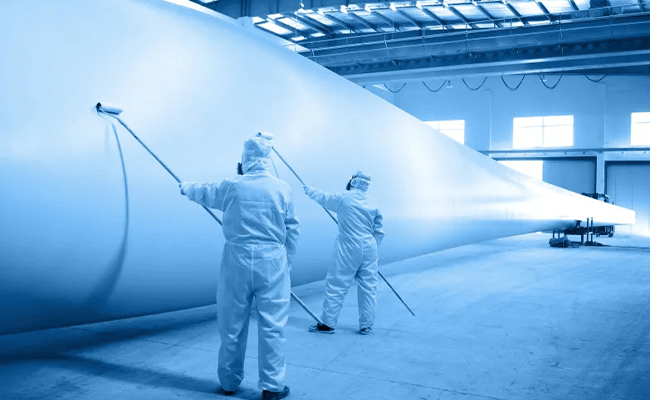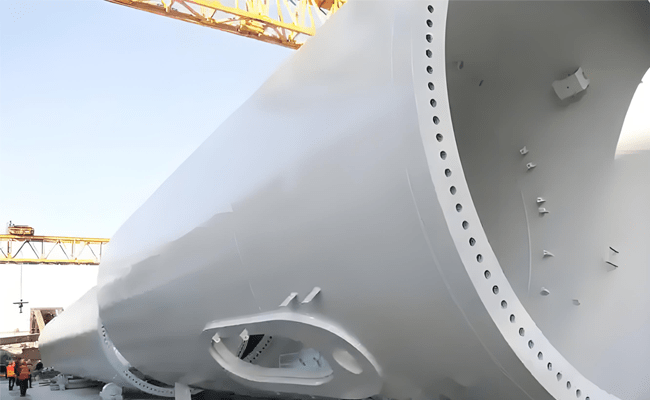1. Wind turbine blade polyurea
Wind turbine blade polyurea coating has significantly improved the service life and operation stability of wind turbine blades with its excellent corrosion resistance, wear resistance, impact resistance, high and low temperature resistance, and hydrophobic self-cleaning performance. Especially in harsh marine and desert environments, it effectively extends the maintenance cycle and reduces operation and maintenance costs. It is an ideal choice for wind turbine blade protection. This article will specifically introduce the development history of polyurea in China.
2. Introduction to polyurea
Polyurea is a tough polymer rubber protective coating. It is made of two liquid components, isocyanate component A and amino curing agent component B, through a mixed reaction. Polyurea was invented in the United States in the 1990s. At first, it was mainly used for corrosion and wear protection of the surface of pickup trucks and truck compartments, and later it was used in the field of national defense and military protection. Polyurea technology has been continuously improving and is now widely used in all walks of life. It is recognized as a “universal” protective material at home and abroad.

The development of polyurea has gone through four stages
First generation polyurea
Aromatic polyurea, arising from aromatic isocyanate and terminal amino curing agent, stands as the most prevalent polyurea, boasting optimal cost efficiency. It features 100% solid content, rapid reaction time (exceeding ten seconds), necessitates thick application using specialized equipment (over 1.0mm), yet demonstrates subpar weather resistance and susceptibility to yellowing.
Second generation polyurea
Aliphatic polyurea, resulting from aliphatic isocyanate and terminal amino curing agent, is priced over 50% higher than aromatic polyurea, presently not widely adopted. It features 100% solid content, rapid reaction (over ten seconds), requires thick application (over 1.0mm) with specific equipment, showcasing strong weather and aging resistance while resisting yellowing.
Third generation polyurea
Polyaspartic acid ester polyurea, known as aspartic polyurea, results from the reaction between polyaspartic acid ester and isocyanate. Typically utilizing aliphatic isocyanate, it exhibits remarkable weather resistance. This polyurea presents a slow reaction speed (ranging from several minutes to tens of minutes), low viscosity, and requires a thin coating (over 0.1mm), applicable through spraying or manual application with a standard sprayer.
Primarily employed as a protective coating on various surfaces, it finds success in safeguarding wind turbine blades, offering corrosion resistance, wear resistance, impact resistance, and reinforcement properties.
Fourth-generation polyurea
Fluorosilicone modified polyaspartic acid ester polyurea, known as fluorosilicone aspartic acid polyurea, is a fourth-generation polyurea derived from the third-generation aspartic acid polyurea. By incorporating functional additives like silicone and fluorine groups, certain properties of aspartic acid polyurea undergo modification while preserving its original traits.
This enhancement introduces hydrophobic, oil-repellent, and stain-resistant self-cleaning features. The high and low temperature resistance range has notably expanded from the typical -40°C to +80°C to a broader -60°C to +120°C range. Such adaptability makes it ideal for challenging environments, including extreme cold, high heat, marine salt fog, and humid regions.
3. Advantages of the fourth-generation polyurea developed by our company for use on wind turbine towers and blades:
1. Corrosion resistance:
It can be used on towers to prevent acid, alkali and salt corrosion below 10% for a long time, and salt spray corrosion resistance ≥4000h.
2. Wear and impact resistance:
It can be used on towers and blades. Wear resistance (750g/500r) ≤20mg, impact resistance ≥1.0kgm, and can withstand the wear and impact of wind and sand for a long time.
3. High and low temperature resistance:
High temperature can withstand 120℃, and low temperature can withstand minus 60℃.
4. Hydrophobic and oil-repellent self-cleaning:
By reducing surface energy and increasing contact angle. Make the coating surface super-hydrophobic, water-free and oil-free, and prevent and reduce ice in winter. Under the action of external forces (wind, vibration), ice cubes are easier to fall off.
5. Convenient construction:
Because of the low viscosity and slow reaction and curing time, it can be sprayed with an ordinary sprayer, or it can be applied by hand or roller.
6. Strong adhesion to the substrate:
The coating is firmly bonded to the metal, composite fiber and other substrates, with an adhesion of ≥6MPa and a smooth surface. 7. UV resistance, aging resistance, and extended wind turbine service life: The protective coating life can reach more than 20 years.
Summary
The fourth-generation wind turbine blade polyurea coating has become an indispensable protective material in the wind power field due to its excellent corrosion resistance, wear resistance, impact resistance and self-cleaning properties. Shanxi Polyurea Protective Materials Co., Ltd. will continue to promote polyurea technology innovation, provide more efficient and durable protection solutions for wind turbine blades, and help the sustainable development of the wind power industry.

